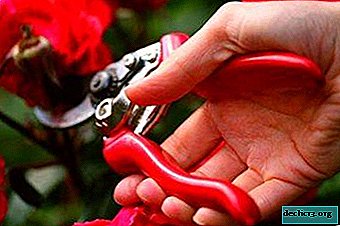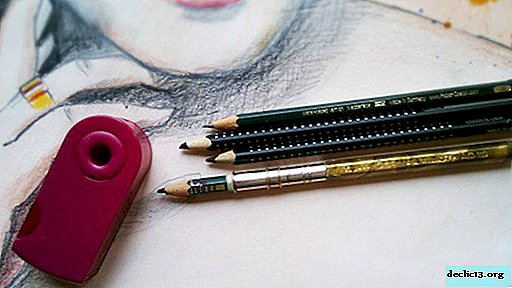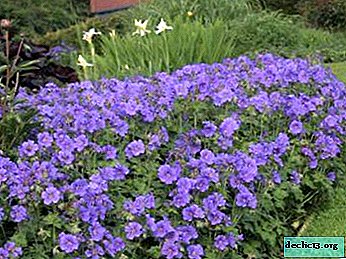Recommendations when and how to prune a Chinese rose

The Chinese Rose plant is very large, so not everyone decides to settle it in their apartment. But there is a very good and easy way to limit the size of the flower to the necessary - this is pruning. With it, you can easily adjust the parameters you need. This unusual plant is able to surprise and delight with its flowering for a very long time. Consider when and how to properly carry out this procedure for a houseplant, whether it can be done in winter and at other times of the year.
When to do pruning at home?
The Chinese Rose can be pruned before flowering in early spring, while buds have not yet formed, also after flowering - in the fall, but not later than September. At a later date - from October to March, the plant can not be cut. If you transplanted a bush in the summer, then after planting it can also be shortened immediately, in other cases, this is not done in the summer.
Features at different times of the year
In the spring
 The flower of the Chinese Rose is formed at the very top of the shoot (young), it turns out the stronger our plant begins to cluster, the more magnificent it will bloom. Therefore, there is no need to be afraid to remove the excess, the bush after pruning will release many new shoots and branches, at the ends of which buds will form.
The flower of the Chinese Rose is formed at the very top of the shoot (young), it turns out the stronger our plant begins to cluster, the more magnificent it will bloom. Therefore, there is no need to be afraid to remove the excess, the bush after pruning will release many new shoots and branches, at the ends of which buds will form.
However, there are still some limitations - it is undesirable to trim more than 2/3 of the total plant volume. It is important to determine the desired shape of the bush before the start of the procedure, and not in the process to avoid mistakes. The place of trimming should be above the kidney facing outward, the cut should be done at an angle of 45 degrees.
In the spring, usually a full pruning of the bush is carried out, that is, all branches are shortened by 2/3. Be sure to remove all the “tops” that grow parallel to the main stem and branches that grow inside the crown.
IMPORTANT! Trimming tools must be very sharp and clean! The cut should be flat and not torn.Fall
It is carried out after flowering has completely completed, it is necessary to shorten all the branches that bloomed. Typically, forming pruning is performed in the fall, that is, 1/3 of the length of the branches. If you grow a small plant, you do not want it to grow up, then you will have to shorten the entire crown - all branches.
All broken and diseased branches (if any) are deletedIt is also necessary to remove the tops if they reappear. There is also such an option - in the fall you can cut the plant to a hemp (leave 5 cm) and put it in a cool place in the shade, and in spring it will begin to grow rapidly.
Pruning old and new plants - is there any difference?
Of course, there is a difference between pruning an old adult plant and a new young plant, let's look in more detail.
- Pruning a new plant - a young new bush requires gentle pruning, which is called pinching. Indeed, for such a plant, there is no need to conduct serious pruning to stimulate the growth of new young shoots. In a young bush, you need to pinch the very tips of all the branches above the upper bud and this will be enough.
 Pruning an old plant - he needs more cardinal pruning - or shortening all the shoots into 2/3 parts, or in some cases, the Chinese Rose is almost completely cut off, leaving a small stump (in the fall). So from such a hemp, one can say, from the roots, a new strong plant grows - such a unique ability is in the Chinese Rose. Thanks to pruning, the old bush undergoes a rejuvenation procedure, gives a powerful impetus to the growth of young shoots and increases the quality of flowering.
Pruning an old plant - he needs more cardinal pruning - or shortening all the shoots into 2/3 parts, or in some cases, the Chinese Rose is almost completely cut off, leaving a small stump (in the fall). So from such a hemp, one can say, from the roots, a new strong plant grows - such a unique ability is in the Chinese Rose. Thanks to pruning, the old bush undergoes a rejuvenation procedure, gives a powerful impetus to the growth of young shoots and increases the quality of flowering.
Purpose of the procedure
Pruning for a Chinese Rose is absolutely necessary to achieve the following goals:
- give a certain shape to the plant;
- remove all twisted shoots of irregular shape;
- remove all diseased shoots (sanitary pruning);
- to rejuvenate the plant;
- achieve abundant flowering.
Step-by-step instruction
To trim to form a bush:
- To begin with, we prepare the tools: a knife and scissors (always sharp and sanitized) and coal (in powder) for processing slices.
- We determine for ourselves the desired shape and approximate height of the bush.
- Then, it is required to cut off those shoots that are parallel to the branches, when the central stem is cut off (thereby freeing up space for the lateral ones to grow), then the side branches turn into real full-fledged stems.
- Next, you need to periodically trim to maintain the desired shape of all branches.
To make the Chinese rose lush:
- This type of pruning is very simple, it is necessary to shorten all branches (preferably in spring and autumn) by 1/3 of the length above that leaf (or bud), which is deployed outward.
- You can also pinch or selectively cut some branches in the summer for better plant splendor.
Possible errors and their prevention
 It is worth paying attention to what mistakes can not be made when pruning a Chinese Rose:
It is worth paying attention to what mistakes can not be made when pruning a Chinese Rose:
- You can not do this procedure during flowering, this can greatly weaken the plant. If you urgently need to remove a diseased branch, then you will have to do this very carefully, without hitting others, be sure to then process the place of the cut.
- You can not cut the flower in winter, at rest, unnecessary processes can start.
- It is forbidden to take poorly sharpened tools and cut them categorically - because in the end you get uneven ragged edges that will not heal well, and the look of the plant will immediately become sloppy.
What will happen if the procedure is carried out?
Important! Some owners of this gorgeous plant, to put it mildly, “regret” cutting it. As a result, of course, they only make him worse. Without the necessary operation, the Chinese Rose will not be able to form beautifully, not to mention the size.The bush will begin to grow as he wants - more on one side, less on the other, moreover, there are less and less leaves, without pruning, the branches are exposed. Shoots can also be deformed, if they are not shortened, then, accordingly, the appearance of the plant does not change for the better.
Flowering will be weak - individual flowers in some places, or even not at all. Cropping is required!
Follow-up care
After completing all the manipulations, the Chinese Rose can be sprayed with Epin for easier adaptation. And then we take care as usual, provide the necessary conditions for its successful growth and flowering.
- Watering - when there is active growth or flowering, then abundant watering is needed so that the soil does not dry out, only the top layer is slightly dried. In cool time (autumn - winter), watering is not needed so often, but in any case, the soil should not dry out, water it about 1 time per week. Water for irrigation is suitable only for standing, soft.
 Humidity - you need to maintain air humidity of about 45 - 50%, for this you can put a fountain near the bush or just a vase of water. It is also necessary to constantly spray the plant, only with soft and warm water, periodically rinse under the shower, the leaves should be clean from dust.
Humidity - you need to maintain air humidity of about 45 - 50%, for this you can put a fountain near the bush or just a vase of water. It is also necessary to constantly spray the plant, only with soft and warm water, periodically rinse under the shower, the leaves should be clean from dust.- Top dressing - it is very good to use complex ones, such as "Rainbow", you need to make them approximately once a month, and during flowering 2 times a month.
- Temperature - in summer, the desired temperature for the plant is 20 - 25 degrees, and in winter you need to maintain about 18 - 16 degrees. Chinese Rose does not like drafts, it is necessary to ventilate the room, an influx of fresh air is mandatory for the flower, but to exclude the ingress of wind (especially cold).
- Lighting - you need good, better on the east window (or west), the light should be scattered, from the direct rays of the sun shade. In the summer, it is very useful to take the flower to the balcony, to fresh air.
Watch a video on the topic: “Caring for a Chinese rose at home”
Learn more about caring for a Chinese rose here.
Conclusion
What conclusion can be made? Only one conclusion suggests itself - there is no need to be afraid that you will not be able to cope with such a powerful plant. After all, it is responsive to all useful manipulations, easily amenable to cropping and shaping. As a result, you yourself will create the shape that you want and you can adjust the size of the Chinese Rose at your discretion. This is very interesting and very fascinating, maybe you can create some unique form of your own.

 Pruning an old plant - he needs more cardinal pruning - or shortening all the shoots into 2/3 parts, or in some cases, the Chinese Rose is almost completely cut off, leaving a small stump (in the fall). So from such a hemp, one can say, from the roots, a new strong plant grows - such a unique ability is in the Chinese Rose. Thanks to pruning, the old bush undergoes a rejuvenation procedure, gives a powerful impetus to the growth of young shoots and increases the quality of flowering.
Pruning an old plant - he needs more cardinal pruning - or shortening all the shoots into 2/3 parts, or in some cases, the Chinese Rose is almost completely cut off, leaving a small stump (in the fall). So from such a hemp, one can say, from the roots, a new strong plant grows - such a unique ability is in the Chinese Rose. Thanks to pruning, the old bush undergoes a rejuvenation procedure, gives a powerful impetus to the growth of young shoots and increases the quality of flowering. Humidity - you need to maintain air humidity of about 45 - 50%, for this you can put a fountain near the bush or just a vase of water. It is also necessary to constantly spray the plant, only with soft and warm water, periodically rinse under the shower, the leaves should be clean from dust.
Humidity - you need to maintain air humidity of about 45 - 50%, for this you can put a fountain near the bush or just a vase of water. It is also necessary to constantly spray the plant, only with soft and warm water, periodically rinse under the shower, the leaves should be clean from dust.















